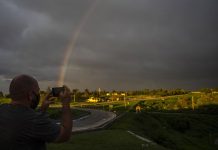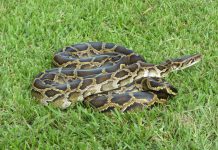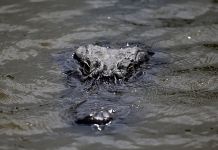Nonprofit hopes to release hard shell clams
SARASOTA, Fla. (AP) — Sarasota Bay Watch Inc., the area nonprofit that already introduced millions of scallop larvae into Sarasota Bay, is starting an ambitious program to release more than 175,000 southern hard shell clams into the estuary.
About 3,000 clams were placed in the New Pass area on April 20, as a test case.
The hope is to bring the species, one of which can filter almost 50 gallons of water per day, back to Sarasota Bay.
Rusty Chinnis, chairman emeritus and one of the founding members of Sarasota Bay Watch, noted that clams have a lifespan of almost 30 years.
That, in one way, makes clams a more cost-efficient species than scallops for the 11-year-old nonprofit to concentrate on in its all-volunteer effort to both maintain and improve the quality of Sarasota Bay.
The first large-scale introduction of clams into the waters of Sarasota Bay is scheduled for May 12. As many as three more trips are planned in June and a total of eight through the summer.
The hope is that eventually southern hard shell clams will reproduce and thrive in Sarasota Bay — helping to clean the water, as well as contribute to the food chain.
“The very presence of these animals creates a minor ecosystem that, without them, wouldn’t occur,” said Jim Culter, a senior scientist at Mote Marine Laboratory who both specializes in benthic ecology and supervises Mote’s shellfish restoration program.
In concert with the Sarasota Bay Watch planting effort, Culter is running a study to determine what environment gives the hard shell clams a better chance of survival.
“Mollusks, particularly filter-feeding bivalves, are considered a key component of coastal ecology, and we should make an effort to keep them around,” he added.
Charismatic clams
Sarasota Bay Watch chose scallops as the first bivalve to reintroduce to Sarasota Bay partly because they grow quickly and partly because adult bay scallops can filter a lot of seawater as they feed — as much as 1.5 quarts per hour, or more than 90 gallons of seawater per day, according to the Florida Marine Research Institute.
“They’re charismatic and they have the blue little eyes and they were virtually gone from the bay,” said Larry Stults Jr., co-president of Sarasota Bay Watch.
“About 10 days old, they want to stick to seagrass, and they stick to seagrass until they start making their shells,” he added.
Scallops thrived in the bay up until the late 1960s to early ’70s, as water quality deteriorated, partly because of runoff from development, agriculture and untreated wastewater.
In August 2008, Sarasota Bay Watch hosted the first Great Sarasota Bay Scallop Search. Snorkelers found 826 scallops — an indicator of improving water conditions in Sarasota Bay.
Though numbers diminished in subsequent counts, the nonprofit secured grant money from a variety of sources — including the Gulf Community Foundation, Community Foundation of Sarasota County, START, the Sarasota Bay Estuary Program and, more recently, the Disney Conservation Fund.
In the fall of 2011, Sarasota Bay Watch first started seeding the bay with hatchery-bred baby scallops, raised at Terra Cia-based Bay Shellfish Co., owned and operated by Curt Hemmel.
‘Clamtastic’ Scallopalooza
Sarasota Bay Watch’s effort is one of the largest and longest-running restoration efforts in the state. Over the past six years, Stults said Sarasota Bay Watch has released 100 million scallop larvae, another 120,000 juvenile scallops and, more recently, some full-grown adults into Sarasota Bay.
The larvae have a high mortality rate, but it’s too costly to grow scallops to an adult size before releasing them into the wild.
“We had some successes; we were starting to see some adults,” Stults said. “They grow really fast, they live a year, they spawn and that’s it.”
They’re also susceptible to red tide — so back-to-back years of red tide flowing into the bay didn’t help the effort.
With that in mind, the scallop restoration will continue, but Sarasota Bay Watch is shifting resources to the southern hard shell clam.
The clams used by Sarasota Bay Watch were all grown by clam farmers in the Boca Grande area. In addition to grants, money has come from the nonprofit’s major annual fundraiser Scallopalooza, which picked up the tag line “It’s clamtastic” in 2017.
Among the many benefits, clams are less expensive to grow to an adult size for release, so they’re not as vulnerable to crabs, rays and other predators.
Still, Stults noted, it took close to two years — at a cost of about $18,000 — for this batch of clams to grow to the size that they’re more likely to survive their natural predators.
“It is a long-term and, for us, not an inexpensive endeavor to put on this restoration effort,” he added.
‘Shoot for the sky’
Culter’s study for Mote Marine will examine whether specific spots of the bay will prove better protection for the clams.
“Are they going to be able to burrow into the sand adequately or do we have to hand plant them in the sand, in the mud, where they would be less susceptible to predation of things like stone crabs, whelks and rays?” Culter said. “We’re going to put some in sea grasses and coarse sand (and) a combination of deeper and shallow habitats and see which habitats survive best.”
Culter said he’s seen cownose rays hunting for clams disturb softer sandy sediment enough with their wings to uncover clams.
Culter will be able to plant his test batch of clams and find them again with GPS coordinates, since they don’t migrate.
When Stults counted off good things about the clams — their long life, their thick shells — he took special note of their relative resistance to red tide as they filter water and dine on plankton.
Once prevalent in the bay, “they would sit there and eat up the red tide and lessen the effect of red tide in our bay,” he said.
The filter feeding already cleans water and reduces the nutrient load in the water.
“If you have clearer water, the sunlight would penetrate deeper and we would have grass growing in deeper parts of the bay,” Stults said.
Fewer nutrients in the water would, in theory, reduce the possibility of red tide blooms migrating into the bay.
While it is hoped that clams and scallops released into the bay will help clean the water, Sarasota Bay Watch also hopes that the clams and scallops will eventually spawn enough that the populations would flourish again.
Culter noted that, for scallops, a population density of four to six animals of reproductive age per square meter would be needed. For hard clams, a similar but slightly less density would be needed.
The natural extension of that, Chinnis noted, would be an opening of scalloping or clamming on either a recreational or commercial level.
“It’s maybe a little bit of a pipe dream right now,′ he added. “But you’ve got to shoot for the sky.”
___
By Earle Kimel. Information from: Sarasota (Fla.) Herald-Tribune, http://www.heraldtribune.com














